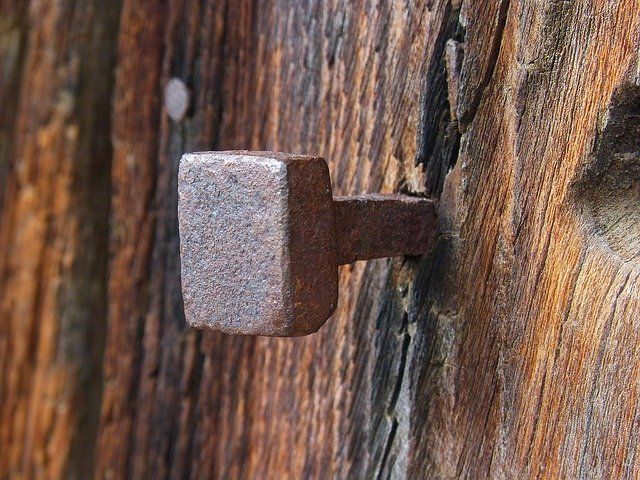Fast and easy nail hole repair
Hanging pictures and wall art leaves holes when an item is moved. Fixing these nail holes is easy. Read on to learn how.

The situation
Hanging pictures, mirrors, wall art and other decorative items makes spaces your spaces. And, rearranging them to suit a new theme or to move to a new domicile is easy.
However, for every wall hanging item moved, a hole remains in the sheetrock, wood or plaster. Fastidious people such as myself do not like seeing unpatched holes; it mars the wall's aesthetic. Also, in a rental, landlords may view even these tiny holes as deductions from your damage deposit.
Avoid surrounding surface damage in plaster and wood
Before diving into repairing nail holes, let's review the right way to install picture hangers, aka nails in plaster and wood. Driving nails into plaster and wood requires special care to avoid damage to the surrounding area. Just pounding a nail into either can pop out a large chunk of plaster or split wood.

Drill a pilot hole - This is the best approach in my experience. Select a drill bit slightly smaller than your nail, and drill pilot holes at a downward angle into the wall. Now you can nail in the hanger.
Tap, tap, tap the nail in - While this sounds like a line from a fairy tale, it is a technique I've developed over the years. Put the nail in position and tap with moderate force to break the surface and start pushing the nail into the plaster or wood. Tip: If you are using a nail and hanger set, put the hanger on the nail first. It is best not to remove the nail after seating it.
Plaster tip: When removing a nail from plaster, go slowly and use moderate pressure to pry the nail out. If the nail seems frozen in place, gently tap it inward a few times to break it loose. The issue is this, nails in plaster can corrode from a chemical reaction with the plaster, becoming stuck. Pulling a nail out suddenly can pop out plaster around the hole.
What? No tips for drywall?
No, I am not being a sheetrock snob or drywall denier. It's just that there is little damage done by driving a nail into these gypsum and paper products. About the worst that can happen is you wind up for a mighty blow with your hammer and you miss, I believe "wiff" is the operative term, and create a lovely crescent indentation in the wall. Oops! Well, keep reading because repairing a dent is the same as a nail hole, you just use more spackling.
The simple-fixes solution
Fortunately for hole-patchers everywhere, their repair is a piece of cake. All you need is hole patching material and a putty knife. But, what if you don't have either of those? In these situations, flour, water and your finger come to the rescue!
Tools and materials
- Putty knife - Use one with some flex, if possible.
- Wall spackling - I prefer the lightweight, fast-drying variety. Water-based only.
- Sandpaper - 220 grit or finer
- Paper towels


Step-by-step
- Remove the hanger/nail carefully from the wall. Go slowly and pull out at the angle of the nail. This prevents or at least limits damage around the nail hole. Note: This isn't much of an issue in sheetrock; still, it pays to be careful.
- Remove any loose material around the hole.
- Use your putty knife to remove a small amount of spackling and drag the knife, spackle side towards the wall, over the hole. Tip: Holding the spackling container under the knife catches any spackling that falls off, reducing cleanup later.
- After you fill the hole, gently wipe over it with a damp paper towel removing all spackling except in the hole.
- Using a damp paper towel, remove all the spackling from your putty knife. Dry the tool and put it back where it belongs.
- Allow the spackling to dry, sand the area flat if necessary and touch up the color as needed.
Technique Note: If you have a bit of a crater around the hole, quite common in plaster, make sure you use enough spackling to cover the entire diameter of the damage. Keep your putty knife perfectly flat against the wall and drag gently across the hole. Too much pressure on the knife can strip out spackling. Also, you may need to make multiple passes to completely fill the hole. Let the spackling dry between coats.
Alternatives to a putty knife
Let's say you do not have a putty knife in your DIY tool kit. Never fear; there are several alternatives at hand.
Your finger - Put some spackling on your finger and smear it across the hole. See, I told you your options are handy, "fingery" in this case.
A kitchen spatula - Smaller models are preferable, but any will work. CAUTION: If it isn't your spatula, ask permission to use it first and avoid animated discussions later.
A credit card - It's flexible and flat, perfect for this use. An expired one is best, but any will work as long as you keep the spackling off the chip and magnetic stripe.
A popsicle stick - If you do not have any in the house, buy a box and eat one as part of your project expenditures. Just make sure you clean off all residue of the goodies, so you don't stain the wall.
"Spackling, we don't need no stinking spackling!"
Fans of the classic of the silver screen, "Blazing Saddles," will understand the title for this section. It's hard to resist a good reference opportunity! Spoiler alert: This movie absolutely could not be made today. It pokes fun at everyone and is chock full of microaggressions. You've been warned.
Spackling is an occasional-use product for most DIYers. Even when kept tightly sealed, the spackling eventually dries up, typically 15 minutes before you need it. If you are dealing with a simple hole repair without surrounding damage, you can make your own spackling. Note: All subsequent steps apply in each case.
Flour and water - Mix a thick paste and use it like spackling.
White or craft glue - Apply a drop over the hole and wipe it with a damp paper towel. Make sure you use water-based glue to avoid cleanup problems.
Add the finishing touches
The last step is to match the patch to the surrounding wall color. I've found patches in white and pale colors are generally acceptable after the repair. If this is you, this project is done!
However, the little white circle in darker colors stands out like a facial zit on prom night. In the ideal situation, you have leftover paint which you use to blend the patch into the surrounding wall.
Tools required
Small paintbrush - Ideally one for craft and model work.
Step-by-step
Gently apply a bit of paint to the patch and feather it to match the surrounding texture. Note: More than one coat may be necessary.
What if you don't have any leftover paint?
Fear not; there are simple fixes for these situations, several listed below. This can be a fun challenge. Get creative with how you resolve the problem.
Arts and crafts felt-tip markers of the approximate color or blend a couple of different colors on the patch for a closer match.
Hobby paints - If you are a modeler like me, you have tiny bottles of paint around the house. See if one is close enough to the wall color.
Go to a hobby or arts and crafts store and buy a small bottle of paint. Tip: Take a picture of your wall as a color reference. While the color match isn't perfect, it's close enough to select a paint.
Apply any art materials you may have including pastel sticks, acrylic paints, etc.
For wood, scratch repair pens are great, as are black fine-tip Sharpies. Shoe polish serves rather well in certain situations. But it requires a bit of finesse to use without affecting the surrounding wood.
Other options
Suppose we say that you simply are not interested in patching a bunch of holes. Hey, this is a judgment-free DIY zone! You do you, dude. That said, how about these creative alternatives to the patch and color process?
Hang your dartboard in the area with the most holes. You add more as you sharpen your dart skills.
Make more holes and create a tiny work of art. You could make all the constellations visible from your hemisphere. Or you can create a connect-the-dots puzzle. Very cool!
Leave the nails and connect them using colorful wire or string. You may be familiar with the string art kits of the second half of the last century. Go all mid-century modern with your design.
Skip the holes in the first place
Of course, you can skip the holes in the first place, making repair or creative repurposing unnecessary.
Picture molding - Older homes sometimes have picture molding attached just below the ceiling. This millwork is installed to hang pictures, mirrors, tapestries and such not, using hooks and wire. We've had two homes with picture molding and it is terrific! Tip: Paint the wires the same color as the wall, making the suspension mechanism nearly invisible.
3M Command products - This product line from 3M directly addresses wall damage or, more precisely, avoiding it. It is a great product and can hold some hefty items. We've used it for years with great success. There is one caveat from my point of view, and that comes to using 3M Command products for heavy items. We have some very beefy pictures and mirrors that I feel uneasy trusting to the adhesive power and longevity to keep these items secure. We are blessed with picture molding for those items and don't have to try our luck.
Cautionary note: Be sure to test this product on your surfaces as there are reports of the adhesive removing the paint, the precise thing it is supposed to prevent. It has worked perfectly for me but a word to the wise is worth repeating. Hum, I believe I mixed some metaphors there...
Closing thoughts
Hole repair in walls is an easy DIY project that you can do with items and materials already in your home. Don't stare at these little blemishes anymore; cover them up!
Thanks go out to Charlotte B. for suggesting this as a topic for a Simple Fixes blog post.
